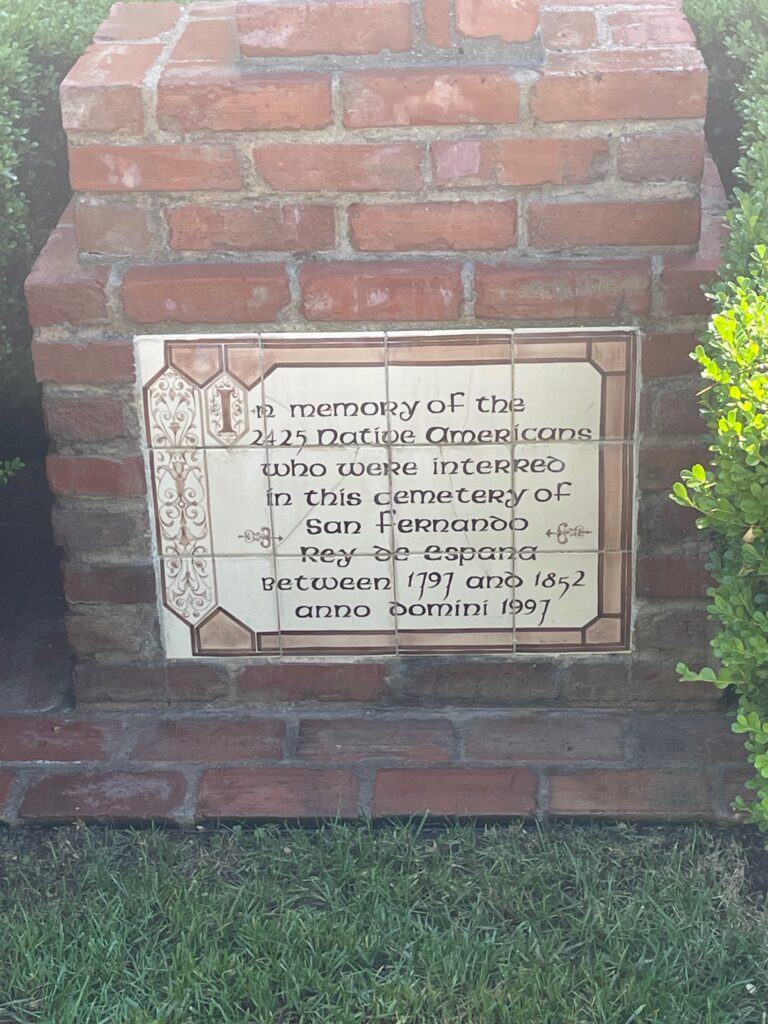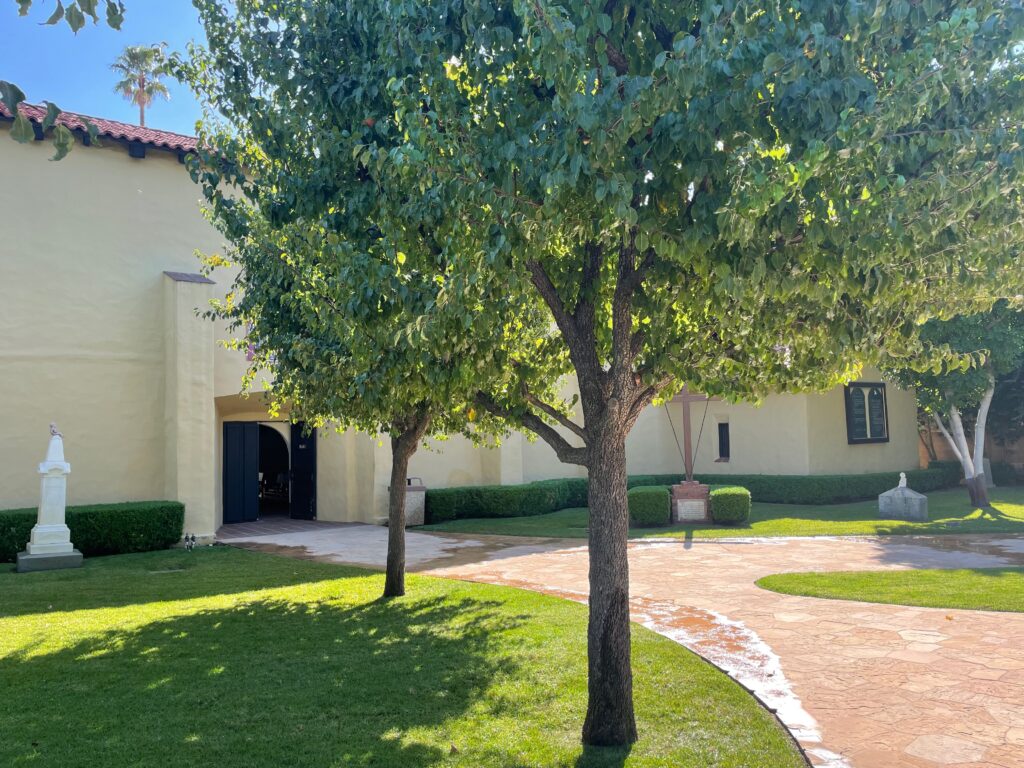Erik Visits an American Grave, Part 1,601
This is the mass grave of the dead indigenous people at San Fernando Mission in California.


The Spanish intended the California mission system as a way to extend its power up the Pacific Coast and stop the Russians from extending south, as well as to “save” the souls of the indigenous peoples who lived in California. Those peoples tended to live in fairly sedentary groups. There were lots of different tribes and mostly they weren’t that large. This meant they would be relatively easy to capture, force to work, and force to convert to Catholicism. The San Fernando Mission was founded in 1797, so relatively late in the process. It was the 17th of the California missions.
The Spanish missions were pure genocide. The Franciscans were good recordkeepers, so we have a pretty good guess as to how many people did die at this and other missions–2,425 people were buried out here in was is today basically the back yard of the mission. The missions were mostly set up in the same way–slave labor camps with a gild of religion on top of this. The idea was to create a sort of “praying Indians,” to borrow from the Puritan form of this, who would both come to the Church and also provide all the labor the Franciscans required and demanded. The Franciscans enforced this harshly. It was enslavement. At least 90,000 indigenous people were kept under close watch and doing forced labor in California. Not all missions were exactly the same of course. A lot of it depended on who ran them. Different friars did approach this differently. Some were horrible, some were…less horrible I guess. But the Spanish soldiers almost universally treated the tribes with tremendous violence.
It’s hardly surprising that many would die. For one thing, you have disease epidemics, which continued to rip through the tribes from time to time. This particular mission was founded after the 1770s smallpox epidemic decimated indigenous peoples through both North and South America, but these smaller and less mobile tribes tended to get it worse than more mobile tribes traveling in smaller groups, so by the time the Spanish opened San Fernando Mission, they would have had an already diminished population to conquer.
Moreover, the Franciscans tried to create high birth rates in order to have a next generation of labor. They suspected, rightfully I suppose, that indigenous people understood their bodies and did not want to have unlimited pregnancies. That did not serve the Church, nor does it today. So after miscarriages, which they assumed were abortions, the Franciscans would do lovely things as put these women in stocks and hold them to carry wooden babies in public. We know of at least one case, at the mission in Santa Cruz, where a friar demanded that a couple have sex in front of him in his office. When they refused, he tried to inspect their genitals. The woman refused that too, fought back, and he had her whipped with 50 lashes and forced to hold the wooden baby. The husband was then shackled and forced to attend mass with bull horns fastened to his head.
From the perspective of the Franciscans, the Indians were children who needed discipline and control. So the idea was to lure them in–beads and food could do that–baptize them, and then force them into a carefully guarded labor discipline. But it was a disaster, even on the terms of the Franciscans. Between 1769 and 1834, the indigenous population around the missions fell from 72,000 to 16,000. In November 1790, Father Fermín Lausén, the successor to mission founder Junipero Serra, a supposed “hero” in California history, wrote back to Mexico City that so far that year, 36 percent of the indigenous people at the missions had died. And that’s with over a month to go!
Moreover, excavations have demonstrated the hard effect of all of this on the human body. They show bones with signs of malnutrition and beatings. Rape was common. Said a French observer in 1786, “corporal punishment is inflicted on the Indians of both sexes who neglect the exercises of piety, and many sins, which in Europe are left to Divine justice, are here punished by irons and the stock.” There is at least some evidence that some friars balked at all of this–this was not what a lot of them signed up for. Some left, others committed suicide or where declared “insane.” But other than a brief moment in the 1770s when the King of Spain ordered an unenforced edict about eventually freeing the Indians after a certain age and time in servitude, there’s no evidence Madrid or Mexico City cared at all.
This genocide is barely known in California mythology. The missions became such a pleasant way to sell old California mythology as that state became such a big part of the American imagination in the early 20th century. Think about Vertigo, where a far more known, if fictional, death took place for most Americans. The mission is perfect for the film, both because it provides an ideal place for such a plot but also because it provides an exotic landscape for a weird film.
I suppose it is good that the remains of these dead people are at least mentioned by the Mission. Of course there is no context here, no meaningful discussion of the enslavement that led to so much of this. The Mission is partly a museum today and so there are exhibits about life there, examples of locally made pottery, and things like this. Naturally enough, you can look at some of the stuff the Indians made under Franciscan “tutelage.” Oh, what craftsmanship! But these things are still owned by the Church and we all know that the Catholic Church refuses to take an honest and critical look at its own history. So there’s nothing on the real horrors that defined this place and time. Just a nice lawn with a pleasant walkway and a sign reminded you that you are stepping on top of a bunch of victims of genocide. No discussion about why 2,425 people are buried beneath your feet. They must have just lived in a nice place at a nice time and the priests were so nice to bury them there!
If you would like this series to visit other people associated with this genocide, you can donate to cover the required expenses here. Junipero Serra is in Carmel, California and I can’t wait for that grave. Fermín Lausén is also in Carmel. Let’s make it happen folks. I need more opportunities to remind you all of largely forgotten American genocides. Previous posts in this series are archived here and here.


